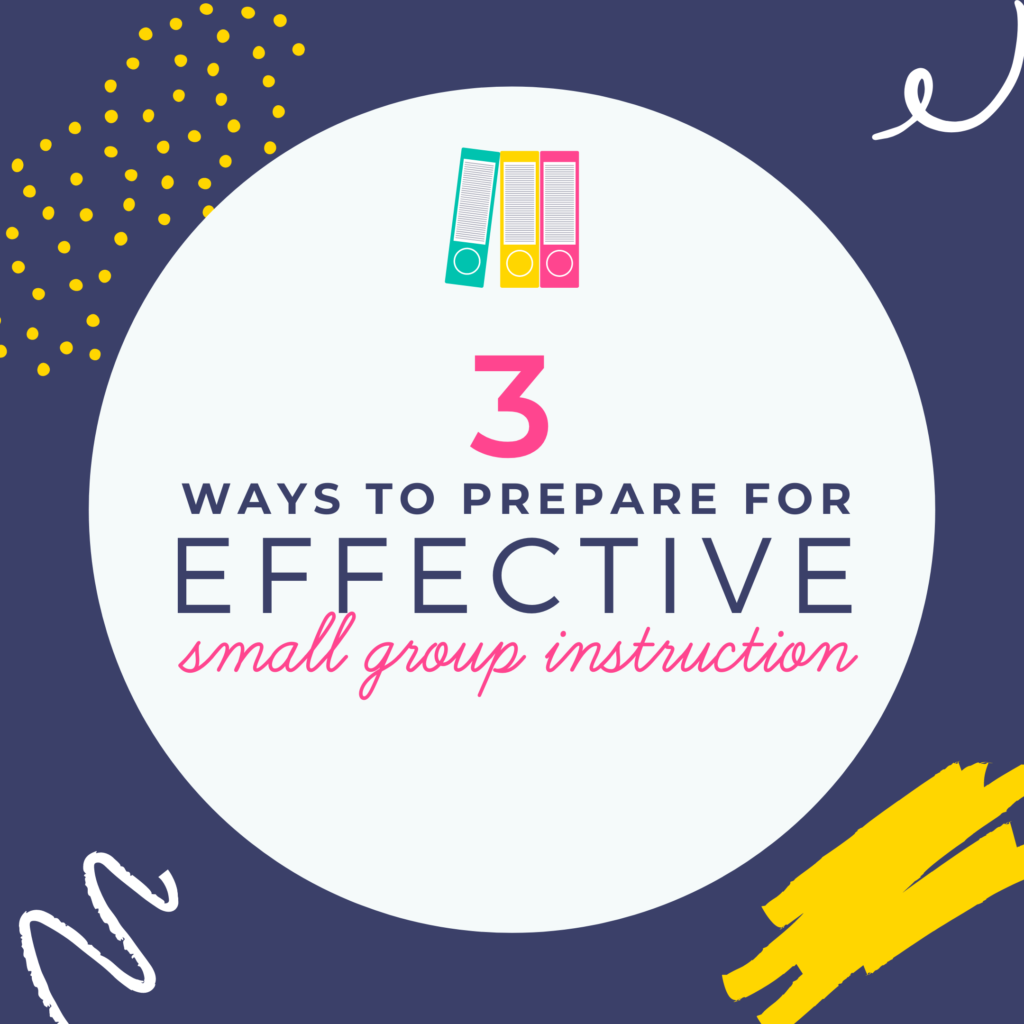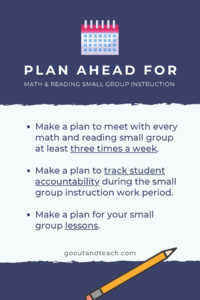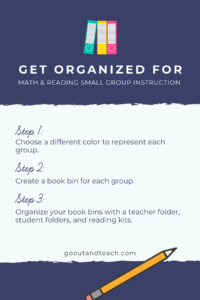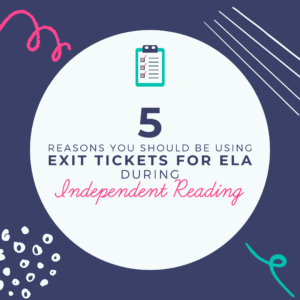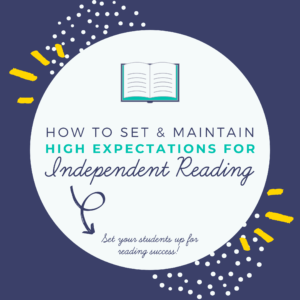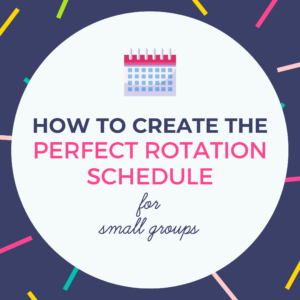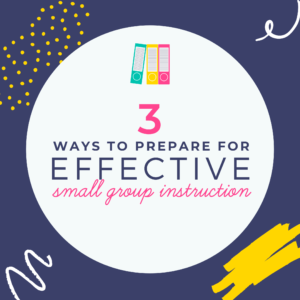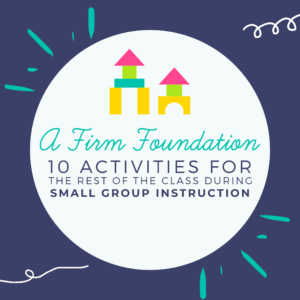Before you start meeting with your small groups, you need to make sure you’ve set a solid foundation that will allow you to maintain effective math and reading small group instruction. There three things you need to do- plan ahead, get organized, and maintain rigor. If you account for all three of these things, you are setting yourself up for success!
Plan Ahead for Small Group Instruction
Always, always, always plan ahead! You never want to walk into your classroom in the morning not knowing what lays ahead. Your math and reading small group instruction time is the same! There are three main components of small group instruction that you need to plan ahead of time- your rotation schedule, how you will track student work, and what you will teach in each group.
Rotation Schedule
Every math and reading small group needs to be met with on a regular and consistent basis. You want to strive for meeting with each group at least three times a week. We like to have a written schedule for ourselves and a schedule displayed somewhere for students to see as well. This could be a pocket chart, list on the whiteboard, etc. The more often you meet with your students and the more consistent you are in maintaining your schedule, the more effective your math and reading small group instruction will be! If you need tips on how to organize your class into groups, this blog post can help!
Tracking Student Accountability
The next thing you want to plan ahead for is tracking student accountability. When you are teaching in your small groups, your attention should be focused on those students sitting with you- not the rest of the room. If you need ideas for what to do with the rest of the class during small group instruction time, you can check out this post!
Once you know what you want your students to be doing, you need to make a plan for how you will hold them accountable. We love to use a specific turn-in table and tracking sheets. To do this you will want to choose one specific place in the room where your students will always turn in the work they complete during small group instruction time. You will also need some folders and student checklists. For each assignment you plan to collect from students during this time, make a student checklist. A thin slip of paper with each students name a a place for a check mark is perfect!
As students complete their work, they will place it in the folder and make a checkmark next to their name. This will allow you to quickly glance over each checklist and see who has and has not completed each assignment. We like to do a quick check in during transitions and give students an update on who’s turned in what. This will remind the students out in the main part of the room to stay focused and on task while you are meeting with your math and reading small groups.
Prepare Your Lessons
Once you have a plan to rotate students through small group instruction on a regular and consistent schedule and a plan to hold the rest of the class accountable during small group time, it is time to plan your lessons. Just like you plan for your whole group lessons, you need to plan for your small group lessons.
Before you ever sit down to teach a small group of students, you want to think through each of the elements you want to address. You should have a clear plan written out or typed out on paper. Thinking through your math and reading small group instruction from start to finish will allow you to make the absolute most of your time and your students’ time! Use every second to your advantage!
Get Organized for Your Small Group Instruction
You know I love a good system, and when that system includes color coding, I get just plan giddy! We always give our groups colors.
- Step 1: Chose a different color for each group. An extra plus- this makes it super easy to display a small group rotation schedule!
- Step 2: Create a book bin for each group. We love these bins from Really Good Stuff, but you could always find a less expensive option Amazon. You can also find some for just $5 each at Target at the beginning of each school year in the Dollar Spot.
- Step 3: Organize your book bins.
We absolutely love utilizing book bins for small group because it allows us to have everything we need for each group at the ready at all times!
We include the following in each bin:
- Teacher folder (same color as the bin)
- One folder for each student (same color as the bin; student name written on the front)
- One reading kit for each student (a great COVID modification to eliminate the sharing of supplies)
Teacher Small Group Instruction Folder:
In our teacher folder, we always have…
- Lesson plan printed out
- Sight word list
- Blank running records
- Any graphic organizers necessary for the lesson
- Any thing else specific to the day’s lesson
Student Small Group Instruction Folder:
In the student folders, we always have…
- Left pocket: all current and past writing assignments (progress drafts and final drafts)
- Right pocket: all inventories, assessment data, completed running records, etc. (stored by date)
Everything that collected and kept in the folder is stored by date. This gives you a wonderful visual of not only the student’s reading progress, but their writing progress as well. It also allows you analyze their data at any time to see where they continue to need addition instruction or interventions.
Maintain Rigor During Math and Reading Small Group Instruction
The third way to to prepare for effective math and reading small group instruction is to prepare rigorous work for your students. Small group instruction time is not meant for games or busy work. While there is certainly a time and place for games in the classroom, this is not that time. And can we all just agree that to not give our students busy work?! There are only so many minutes a day to work with your students, and busy work is a waste of your time and their time. Just say no to the busy work!!
You want to prepare rigorous work not only for your students you meet with during small group instruction, but also for the other students who are working independently. You should never leave your students to work on something that you wouldn’t justify doing whole group. If an assignment or activity isn’t something you would consider valuable enough to devote whole group instruction time to, then it isn’t something students should be working on during small group instruction time.
In maintaining rigor, make sure you have a system in place for holding your students accountable. How are you going to assess their learning that has taken place during this time?
Anything on that is completed on paper pencil or in a platform like Google Classroom can be collected for assessing. Independent reading can be followed by a journal entry, quick write, or accountable talk. And online learning apps or assessments like Moby Max, iReady, etc. can provide you data to be analyzed. Whatever you ask your students to do, make sure that you are collecting it, assessing it, and analyzing the data it provides you. This will give you very clear understanding of where your students are and where they need to go next.
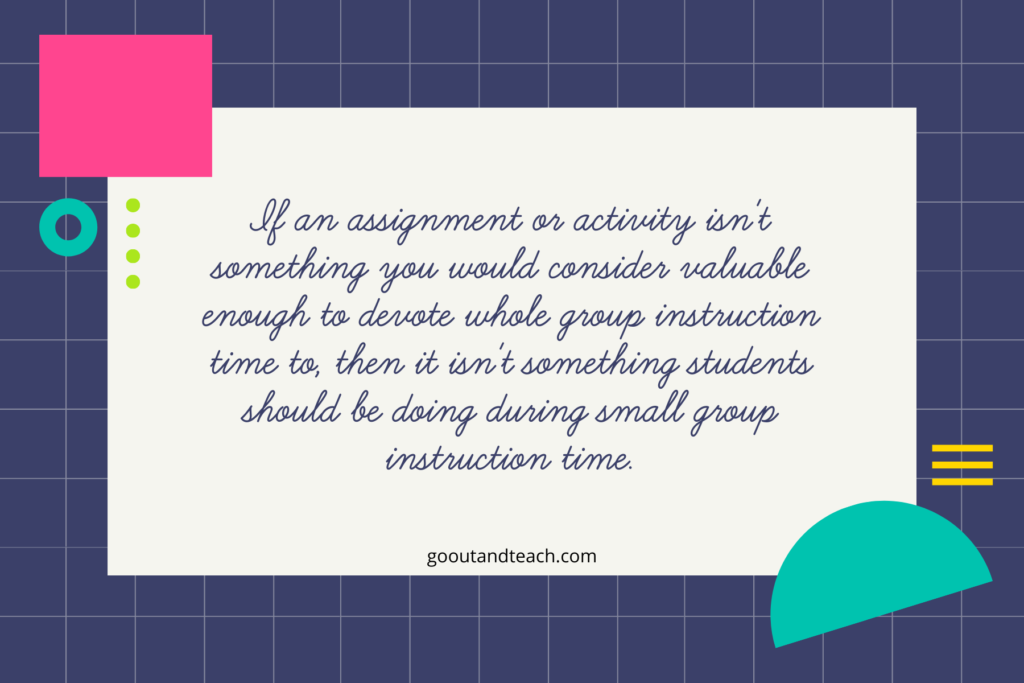
In Review:
Plan Ahead
- Plan your rotation schedule
- Create a plan for tracking student accountability
- Plan your lessons
Get Organized
- Organize groups by color
- Organize a book bin for each group
Maintain Rigor
- Hold students accountable
- Collect, assess, and analyze student work

More Small Group Resources:
If you need help finding time in your schedule for small groups, this post if for you! Need ideas for the rest of the class while you work with small groups? This post has 10 assignment/activity ideas that work well for this! And if you aren’t sure how to organize your class into small groups, this post will walk you through three simple steps for well organized groups!

